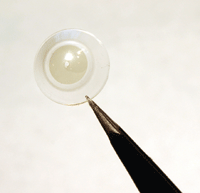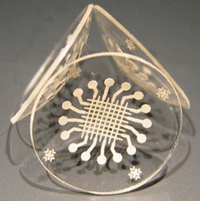 In health care, research is critical to the growth and acceptance of novel materials, treatments and specific protocols. New breakthroughs within the contact lens field may change your approach as an eye care practitioner, including the way you fit a particular group of patients or how you use a specific medical device. Research drives innovative ideas and development.
In health care, research is critical to the growth and acceptance of novel materials, treatments and specific protocols. New breakthroughs within the contact lens field may change your approach as an eye care practitioner, including the way you fit a particular group of patients or how you use a specific medical device. Research drives innovative ideas and development.
There are individuals and companies currently looking to develop new contact lenses with enhanced wetting capabilities, lenses infused with pharmaceutical agents, improved multifocal designs, improved ocular health and lenses that can even alter or shape the developing eye. This month, we look at a few innovative products that hold great promise for our contact lens practices.
Pediatric Lenses
Because fitting children in contact lenses can be challenging, this population is often overlooked. The biggest concern surrounds the child’s maturity and ability to take on the responsibility of maintenance and care. Other practitioners worry about the child’s interest and motivation to wear contact lenses. A final consideration is the child’s personal hygiene habits and ability to take care of the contact lenses without help.1
From an ocular health standpoint, the Contact Lenses in Pediatrics (CLIP) study revealed that there were no differences in the biomicroscopic findings between children and teenagers who wore contact lenses.2 The CLIP study also found that children were as responsible as teenagers in the obligations of contact lens wear.2

1. Scientists are designing contact lenses that can help enhance normal vision through 3D panoramic images.7
Today, however, a growing number of eye care professionals are changing their mindset and fitting more children; this new trend largely can be attributed to the availability of new, innovative daily disposable lenses, improved contact lens materials and recent research demonstrating improved performance in activities and sports.1 Because daily disposables are considered the most convenient to wear and care for, they are often the lens of choice for this population. In fact, a snapshot of the U.S. market over the past few years shows that daily disposable lenses accounted for the most growth within the industry and are expected to continue in that direction.3,4
When discussing contact lenses with the child and parents, make sure to explain why you are fitting a specific modality, and underscore the importance of compliance. Take the time to write out your suggested contact care techniques, because we know:5
• Three in five contact lens wearers do not wash their hands prior to handling the lenses.
• One in five people do not use fresh solution every time they store their lenses.
• Two in five people have put their contact lenses in their mouth to clean them.
• Seven in 10 contact lens wearers admit to wearing their lenses while swimming.
Myopia Control
There has been much research in the area of myopia control, which quickly is emerging as an area of specialty with untapped potential. At the heart of this field of research is this question: “How much reduction in myopia would change your prescribing habits?”
Is it a 25% reduction, 40%, 60% or greater than 80% reduction that would cause you to change your prescribing habit? Personally, if we could tell parents that a 50% reduction in their child’s vision impairment is possible, that seems like a significant number. Or, imagine reducing an “expected” -5.00D myope down to a -2.50D myope through a specific treatment interruption that could slow down predicted axial length elongation.
What is causing an increasing prevalence of myopia? Is it nature or nurture? Several researchers are evaluating the role of genetic predisposition, amount of near work, lag of accommodation, levels of vitamin D and even the amount of time spent outdoors in relation to myopia.

2. Researchers are developing pressure sensing contact lenses, which can
provide glaucoma 24-hour monitoring.
New theories, treatments and specific contact lens designs are being formulated with the goal of aggressively halting accelerated axial length growth associated with myopia development.
These treatments include progressive addition lenses, light-filtering spectacle lenses, soft contact lenses in all materials, rigid gas-permeable contact lenses (standard fit), soft or rigid bifocal or multifocal contact lenses, orthokeratology lenses, pharmaceutical agents (atropine, pirenzepine, 7-methylxanthine) or vision therapy. They are designed to work on various anatomical areas that influence the refractive state—including the anterior and posterior corneal curvature, corneal thickness, anterior chamber depth, ciliary muscle, axial length of the eye and the accommodation/convergence mechanism.
Alternative Uses of Contact Lenses
Researchers currently are investigating ways to produce a contact lens that automatically adjusts its focus depending on the distance. They potentially could use an “electro-active” element layer attached to the contact lens to restore a perfect focus at all distances. Other projects have looked at developing an electronic circuit on a contact lens that could provide virtual displays, including the Internet and GPS via Wi-Fi-enabled lenses.
New research is looking to treat ocular diseases with the use of “smart” contact lenses that could measure pressure within the eye and dispense medication accordingly (see “A Blueprint of Tomorrow’s Smart Lens,” October 2012). These drug-infused contact lenses could be used for the delivery of many different medications. For example, scientists already have developed a contact lens that releases anesthesia to the eye for post-surgery pain relief; these lenses may soon be part of the treatment protocol for our postoperative PRK patients.6
Practitioners today are able to choose from a wide variety of new contact lens materials, lens care solutions, moisturizing eye drops and prescription therapies to improve ocular health. Innovative products and research will continue to drive the market and stimulate growth in areas we may not have considered previously. We recommend that you, as an eye care practitioner, stay current with ongoing research so you can provide the most up-to-date lens care to your patients.
1. Sindt C, Riley C. Practitioners attitude on children and contact lenses. Optometry. 2011 Jan;82(1):44-5.
2. Walline J, Jones L, Rah MJ, et al. Contact Lenses in Pediatrics (CLIP) Study: chair time and ocular health. Optom Vis Sci, 2007 Sep;84(9):896-902.
3. Nichols JJ. Contact Lenses 2008. CL Spectrum. 2009 Jan. Available at:
www.clspectrum.com/articleviewer.aspx?articleid=102473. Accessed October 2012.
4. Nichols JJ. Contact Lenses 2011. CL Spectrum. 2012 Jan. Available at:
www.clspectrum.com/articleviewer.aspx?articleid=106550. Accessed October 2012.
5. Stone R. The importance of compliance: focusing on the key steps. Poster presented at the annual British Contact Lens Association meeting, May 31-June 2, 2007; Manchester, United Kingdom.
6. Contacts release anesthesia to eyes of post-surgery patients. Contact Lens Headlines. 2012 Jan 30. Available at:
www.contactlensheadlines.com/7371/contacts-anesthesia. Accessed October 2012.
7. Choi CQ. Virtual reality contact lenses may exist by 2014. Innovation News Daily. 2012 Feb 2. Available at:
www.huffingtonpost.com/2012/02/03/virtual-reality-contact-lenses. Accessed October 2012.


